Addressing Biodiversity
- Strategy (Stance, Approach, Risks and Opportunities)
- Governance
- Risk Management
- Indicators and Targets
- Major Initiatives
- Performance Data
(Stance, Approach, Risks and Opportunities)
Reducing the Impact of Corporate Activities on Biodiversity
While the corporate activities of SEKISUI CHEMICAL Group benefit from the multitude of blessings of nature brought about by biodiversity, they also place a burden on ecosystems. Recognizing this, we view nature as a form of capital that has value, and will therefore realize returns on the burden of its use through products and initiatives.
We will promote the efficient use of limited resources and energy, and strive to reduce the environmental impact caused by greenhouse gases and hazardous chemical substances while preventing pollution. At the same time, we will endeavor to improve functions and services so that our customers who use our products can contribute to the conservation of biodiversity.
We will work with various stakeholders to conserve and restore biodiversity to realize "Nature Positive*" through environmental considerations and contributions in our business activities and environmental conservation activities around the world, while making returns that have a positive impact on natural capital beyond the natural capital we utilize. We will work to conserve and restore biodiversity toward the realization of "Nature Positive".
- Nature Positive: To prevent damage to biodiversity on a global scale and to increase natural capital in a positive manner.
Land Use Concept
As a general rule, SEKISUI CHEMICAL Group does not use or develop land in the vicinity of protected areas (World Natural Heritage, IUCN Category I, II, III, and Ramsar Convention on Wetlands sites).
We will ascertain the impact of our business activities on biodiversity throughout the global value chain, and will review, minimize, recover, and offset activities in areas deemed important from the perspective of biodiversity.
- Note: Please refer to Biodiversity Policy and Biodiversity Action Guidelines
Biodiversity Conservation Initiatives based on the SEKISUI Environment Sustainability Vision 2050
In order to contribute to the realization of an earth with maintained biodiversity, SEKISUI CHEMICAL Group engages in activities based on its Long-term Environmental Management Vision, SEKISUI Environment Sustainability Vision 2050*1.
As stated in the SDGs, natural and social environmental issues are interconnected, and in order to solve a single issue, we must remain conscious of multiple issues while working to find solutions.
Going forward, the Group will strengthen partnerships with stakeholders and work to evolve its activities, conscious of the need to not only solve issues relating to society, but also those that relate to the natural environment. By doing so, we will contribute to realizing returns on both natural and social capital*2, through which we hope to achieve a nature positive earth.
With this in mind, we have drawn up the following grand design of initiatives that will prioritize by 2050.
- Out_E60
Biodiversity Grand Design
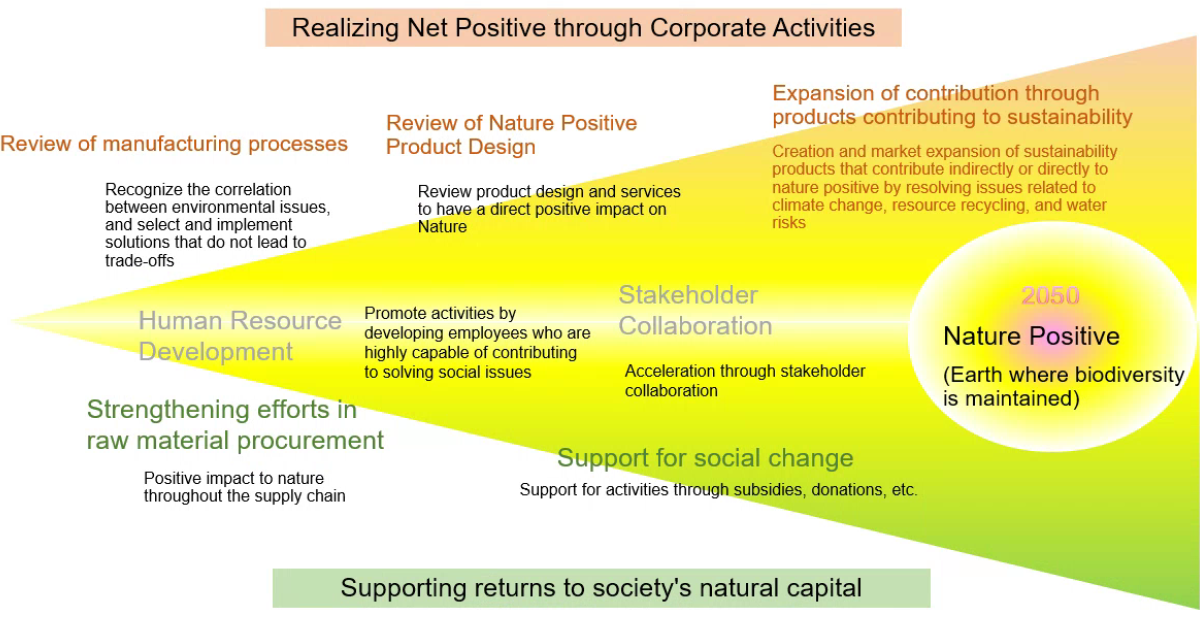
In order to achieve nature positivity and an earth with maintained biodiversity in 2050, the Group will undertake the following initiatives to realize returns on natural capital through its corporate activities.
- Review manufacturing processes
- Review nature-positive product designs
- Increase the degree of contribution through Products to Enhance Sustainability
In addition, we will implement the following initiatives to help support returns to natural capital by society.
- Strengthen initiatives involving raw material procurement
- Support social change
Moreover, we will undertake initiatives aimed at accelerating returns to natural capital through corporate activities and by society.
- Develop human resources
- Collaborate with stakeholders
- For details of the Long-term Environmental Management Vision, SEKISUI Environment Sustainability Vision 2050 see here.
- For details of the Integrated SEKISUI Environment Sustainability Index see here.
Risks and Opportunities
As far as the Group’s biodiversity-related risks are concerned, we have drawn up four social scenarios that are based on two presupposed axes. One axis focuses on the decentralization of social systems in rural areas against concentration in large cities. The other axis focuses on mitigation as opposed to the acceleration of climate change, with temperatures of not more than 1.5°C and not less than 4°Cs. We have examined the impact from a nature perspective on each social scenario and analyzed the risks and opportunities that arise under these impacts.
As a result, we have identified the following as important risks to the Group’s biodiversity.
-
1.Risk of biodiversity impairment with respect to timber raw materials at the procurement stage in the Housing Business
[Ecosystem impact] Concerns surrounding the negative impact of deforestation on biodiversity.
[Company impact] Reputational and procurement risks. -
2.Risk of biodiversity impairment in the event of the illegal dumping of a product on marine ecosystems at the disposal stage after use in the Plastic Molding and Processing Business
[Ecosystem impact] Impact of illegal dumping on marine ecosystems.
[Company Impact] Possible reputational risk. -
3.Risk of biodiversity impairment due to foundation work that entails the modification of land at the time of reclamation in the Town and Community Development Business
[Ecosystem impact] Risk of fragmentation of the habitats of living creatures when fostering town and community development.
[Company impact] Risk that habitat fragmentation may reduce the attractiveness and sustainability of urban environments coupled with possible reputational risk. -
4.Risk of water-related disasters in Southeast Asia due to the impact of climate change on the manufacture and operation of our own and customers' plants.
[Ecosystem impact] Disasters destroy ecological balance
[Company impact] Physical risks
In addition, we analyzed the identified risks using the locate, evaluate, assess, and prepare (LEAP) method. Based on the results, we are advancing the following initiatives in a bid to convert risks into opportunities.
-
1.By procuring from sustainable forests, we are working to avoid risks and ensure a stable supply of housing with a durability of 60 years or more. We recognize that in gaining the understanding and trust of customers, we will be better placed to expand opportunities for housing sales.
-
2.We are endeavoring to develop a resource recycling system that prevents illegal dumping of molded plastic products at the time of disposal. In this regard we have developed a new Biorefinery (BR) technology that produces ethanol from combustible waste through the power of microorganisms. A one-tenth commercial scale demonstration plant is currently in operation with the aim of implementing this technology in society. By establishing a resource recycling system, we recognize the potential to eliminate the illegal dumping of molded plastic products and its impact on the ecosystem. This in turn will help mitigate any deterioration in the reputation of existing products. At the same time, we are prioritizing innovation as a means to address and mitigate risks which can then lead to the development of new business opportunities.
-
3.In order to prevent the fragmentation of the habitats of living creatures across regions, we are strengthening ecosystem bridges by raising the environmental awareness of local residents through the planting of endemic species and awareness-raising activities. As a result of these efforts, we obtained ABINC-ADVANCE certification for Asaka Lead Town, a model for the Group’s Town and Community Development Business. This has allowed us to turn risk into opportunity, as the ecological considerations have helped enhance the attractiveness of the town.
-
4.We are expanding businesses that strengthen water infrastructure in the Asian region thereby reducing risks and generating opportunities.
Past and Future Biodiversity Initiatives
SEKISUI CHEMICAL Group has promoted the following initiatives to address biodiversity.
-
1.Assessment and reduction of the impact of business activities on biodiversity
- Developing assessment methods and conducting assessments, reducing impacts
- Greening of business sites (promoting landscaping and biotope development)
- Promoting biodiversity-conscious purchasing
-
2.Development and promotion of related technologies and products
- Incorporating biodiversity assessments at the product development stage
-
3.Raising employee awareness
- Conducting nature conservation activities at all business sites
- Expanding the SEKISUI Nature Study Course and nature conservation activities
-
4.Dialogue and collaboration with external stakeholders
- Supporting innovation inspired by nature, and holding periodic forums
- Supporting NPO's and other organizations through the Japan Business Federation (Keidanren)
-
5.Transmission of information
- Participating in exhibitions
- Providing education to the next generation (children's nature study course, school visits)
- Publishing sustainability reports, site reports, and posting information of the Company’s websites
Beginning with the current Medium-term Management Plan, we will first take action to resolve environmental issues, which are already underway, while taking into consideration biodiversity (natural capital). In addition, we will strengthen our understanding of the current situation, and if any negative impact on biodiversity is identified, we will find measures that will lead to positive nature results while mitigating negative aspects with the aim of increasing the effectiveness of initiatives.
To this end, we will also expand indicators to ascertain current conditions.
- Out_E61
Biodiversity initiatives in the Current Medium-term Management Plan
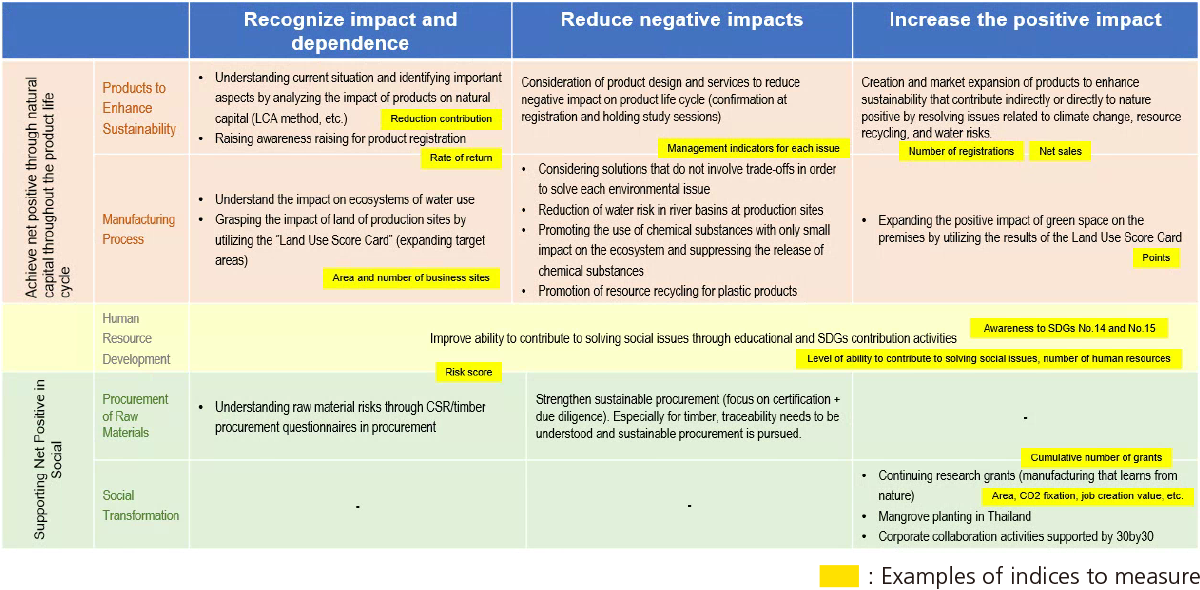
Promotion System for Biodiversity Issues
As far as biodiversity issues that may pose a risk to management are concerned, steps are taken to ascertain the magnitude of each risk and to consider as well as implement appropriate countermeasures under the supervision of the Board of Directors. In similar fashion to other environmental issues, our supervisory and executive systems for reducing the Group’s impact on biodiversity issues and expanding its contribution to the resolution of issues are based on the Environmental Management Promotion System. (For details see here)
When new land is acquired, for example through large-scale land development, such as when constructing our own factories, or through M&As, we carry out environmental assessments of the impact that our business may have on the atmosphere, water areas, soil, etc. During these environmental impact assessments, we also verify any impact with regard to biodiversity.
As far as risk management is concerned, we have established an ERM system that in addition to identifying Group-wide major risks, shares and manages these risks within the Group. Risks related to biodiversity issues are also assessed in an integrated manner, together with other risks that are expected to have a significant impact on management. Risks that affect the Group as a whole and each organization, including such environmental issues as biodiversity, are shared and deliberated at Board of Directors, Sustainability Committee, Management meetings, and subcommittee meetings.
Assessment of Impact on Biodiversity (Natural Capital)
Under SEKISUI Environment Sustainability Vision 2050, SEKISUI CHEMICAL Group is working to realize an earth with maintained biodiversity. To that end, we are promoting initiatives that utilize the net-positive approach toward ecosystems.
We use the SEKISUI Environment Sustainability Index as an integrated indicator to confirm the degree of progress toward realizing our environmental vision. As a result, we calculate the rate of return on natural and social capital, which we consider an assessment of the degree of impact on biodiversity as a whole.
In the future, we will also identify and monitor the impact of two aspects on plant biomass (primary production of plants) and biodiversity (number of extinct species) as a breakdown of this calculation.
We have long been aware that the use of raw materials, emission of chemical substances, and disposal of products sold have a significant impact on biodiversity in our business activities.
Due to the greater understanding of the unique effects of these chemical substances in recent years as part of LCA databases used to monitor impact, the impact per unit amount of chemical substances has been increasing.
In light of this, we are updating the databases we use, reconfirming the benchmark, and expanding returns starting with the targets in the current Medium-term Management Plan.
SEKISUI CHEMICAL Group confirms the return rates of both plants (primary production of plants) and biodiversity (extinction rate of living species). The data in each case is used as a confirmation indicator to enable the Group to have a direct positive impact. The following table outlines trends in the aforementioned. Although the return rate in each case remains below 100%, we will promote corporate activities that move steadily toward nature positivity by addressing such environmental issues as climate change and resource recycling.
Trends in Rates of Return to Biodiversity and Plant Primary Production
| FY2017 | FY2018 | FY2019 | FY2020 | FY2021 | FY2022 | FY2023 | |
|---|---|---|---|---|---|---|---|
| Biodiversity aspects | 38.3 | 39.4 | 43.1 | 40.8 | 49.7 | 38.0 | 30.5 |
| Plant Biomass aspects | 35.0 | 35.1 | 34.9 | 38.2 | 41.0 | 67.8 | 50.4 |
Among the raw materials used by the Group, biomass-derived paper and petroleum-derived materials have a significant impact on biodiversity.
In order to reduce this impact, we recognize the importance of strengthening procurement in a manner that takes into account sustainability with respect to non-fossil resources as stipulated in our resource recycling policy.
With the aim of bolstering the sustainable procurement of raw materials, we have also reviewed items that need to be considered in supplier management. Based on the aforementioned, we are engaging in activities with a view to reducing environmental impact and corporate risks in cooperation with suppliers.
Meanwhile, products that contribute significantly to the conservation of biodiversity include those that contribute to the reduced use of minerals, fossils, and forest resources. These include products that contribute to resource recycling by reducing energy consumption during the use of vehicles and transportation, improving durability, and switching to alternative materials. Examples of the former include KYDEX, LLC products for aircrafts and railroads. Examples of the latter include products related to the SPR method for sewage pipe restoration.
Products that contribute significantly to the primary production of plants include, for example, products that curb global warming and products that can reduce waste.
Examples of the former are Sekisui Heim's solar panel-equipped houses, and the latter are Kraft tapes that enable the use of thinner paper cores than previously possible.
In order to expand these contributions, it is important to develop products and technologies that contribute to decarbonization, and to establish services and technologies that reduce the waste from products sold while promoting recycling. With this in mind, we are working to achieve the aforementioned goals by expanding our lineup of Products to Enhance Sustainability.
In fiscal 2023, the rate of return to plant biomass increased. We believe this increase can be attributed to a variety of factors, including the reduced use of raw materials that have a negative impact, improvements in the quality of green spaces at production sites, and contributions from products that have a positive impact on the land used.
As far as biodiversity is concerned, we also recognize that increases in the impact of chemical emissions and the decrease in sales of products that contribute to biodiversity have led to a decline in the rate of return.
Going forward, we will continue to promote manufacturing while examining the direction of these return rates in order to engage in nature positive corporate activities.
Targets related to Addressing Biodiversity
JBIB Land Use Score Card Points
Current Medium-term Management Plan (FY2023-2025) Targets +3 points over a 3-year period (compared with FY2022)
FY2023 Results +1.5 points (compared with FY2022)
2030 Target Promote ecosystem consideration* at all business sites
2050 Target Maintain ecosystem consideration at all business sites
-
* Ecosystem consideration:Increased quantitative evaluation of biodiversity
Innovation Inspired by the Nature Research Support Program and Holding of Forums
Since 2002, SEKISUI CHEMICAL Group has provided grants for manufacturing with a focus on learning from nature, while also holding forums to share the results of research work. As an effective approach to manufacturing that is geared toward the resolution of social and environmental issues, we recognize the critical need to learn from nature’s wisdom. With this in mind, we are implementing various measures develop biomimicry* technology.
While basic science requires time for research and support, we believe that learning from nature's wisdom has the potential to create fundamental innovations that differ from conventional energy-consuming technologies.
By providing these grants to researchers outside the Company, we have supported the development of 306 technologies (cumulative total as of the end of March 2024). Amid efforts to promote development based on this understanding, the following technologies and product examples have emerged. (See the diagram below)
- Biomimicry (biomimetic) is the use of what is learned from the mechanisms of nature in the development of technology. The term is a combination of "Bio," meaning living things, and "Mimicry," meaning imitation.
- Out_E62
[Contribution to a next-generation telecommunications society]

Transparent flexible reflector film developed from studies of the brilliance of morpho butterfly wings
- Out_E64
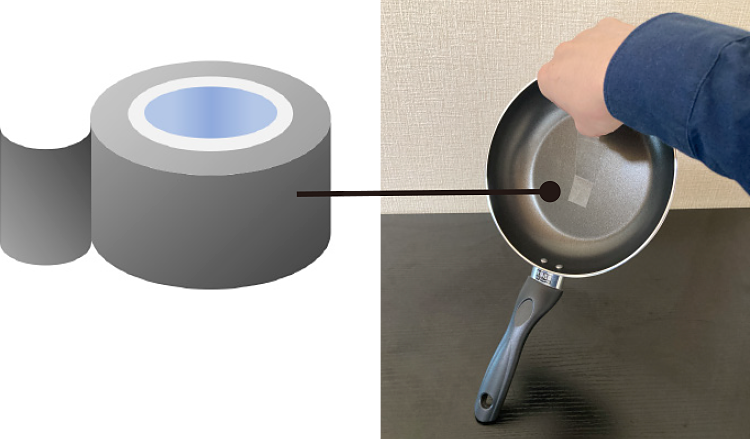
Fluoroplastic-compatible adhesive tape developed from the study of mussel secretions
- Out_E66
[Contribution to extending healthy lifespans (and COVID-19 countermeasures)]

Viru-taker™ and Allerbuster developed from the study of plant-based resins
- Out_E68
[Contribution to addressing climate change (heat island effect countermeasure)]
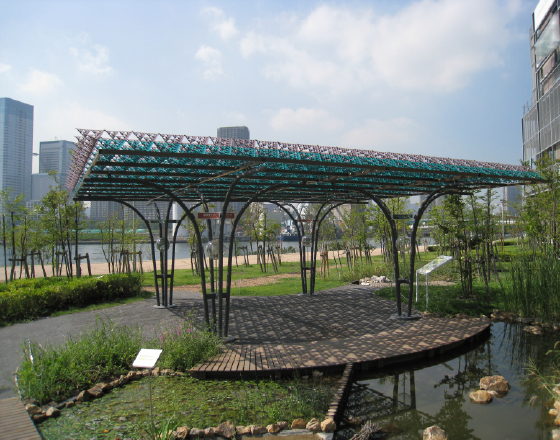
Fractal sunshade material Airyshade developed from the study of the cool shade of trees
We will continue to develop nature positive products and businesses by placing considerable importance on learning from nature's wisdom in our manufacturing activities.
Use of Sustainable Timber and Ensuring Traceability
SEKISUI CHEMICAL Group promotes the use of FSC-certified and other legally harvested timber, as well as timber that has been confirmed to be sustainable through direct engagement. In this manner, we contribute to the eradication of deforestation and the sustainable use of timber resources. In addition, we conduct surveys on commercial distribution with a focus on the logging area, tree species and quantity of timber materials to ensure traceability. For recycled materials, we use timber- and timber-based materials that are already in use in the market, unused thinnings, and branches.
In 2022, we set the target of eliminating deforestation by 2030. As a part of efforts to achieve this target, we revised our Timber Procurement Policy* and put in place Sustainable Timber Procurement Guidelines to facilitate procurement in line with this policy. In addition to the legal procurement of timber, we are also promoting initiatives to reduce the impact of deforestation on the human rights of indigenous peoples and the environment.
- For details of the SEKISUI CHEMICAL Group Timber Procurement Policy see here.
Initiatives to Improve the Quality of Green Spaces
SEKISUI CHEMICAL Group is implementing initiatives to improve the quality of green spaces at all of its domestic production sites and research institutes.
We are promoting initiatives to improve the quality of the green spaces within our 45 business sites in Japan (total site area: 3,282,000 m2, total green space area: 855,000 m2) in an effort to improve the habitats of local flora and fauna, build an ecosystem network that connects local communities and business sites, and revitalize regional cooperation. Utilizing the JBIB Land Use Score Card®, we are aiming to improve our score by three points compared with FY2022 during the period of the Environmental Medium-term Plan (FY2023-2025).
Under the guidance of the environmental consulting company Regional Environmental Planning, Inc.,, we engaged in a variety of activities, including the following.
- Planning and implementation of green space design as well as management plans in harmony with the surrounding natural environment
- Sustainable maintenance and management utilizing the natural cycle
- Eradication of invasive species
- Conservation of rare species
- Communication with stakeholders
As a result, our average score for FY2023 improved by 1.5 points compared with FY2022.
Activities to Survey Non-native and Conservation Plant Species and to Eradicate Non-native Plant Species
Many non-native species have invaded our surrounding, firmly taking root. Some of these are plants that damage ecosystems, including those that deprive native species of their habitat, and others are plants that are harmful to people.
Under these circumstances, SEKISUI CHEMICAL Group has conducted surveys of exotic and precious plants in and around its 27 plants and offices in cooperation of experts since fiscal 2018.
Based on the results of the survey, we have selected those species to be eradicated and those to be preserved, and have prepared a countermeasure manual that outlines appropriate eradication methods and timing, which we are using while continuing to engage in eradication activities.
In order to create and maintain a better environment within business sites, we recognize the need to manage green spaces with biodiversity in mind, while focusing on non-native species and species conservation (precious species).
- Out_E69
- Out_E70
- Out_E71
-
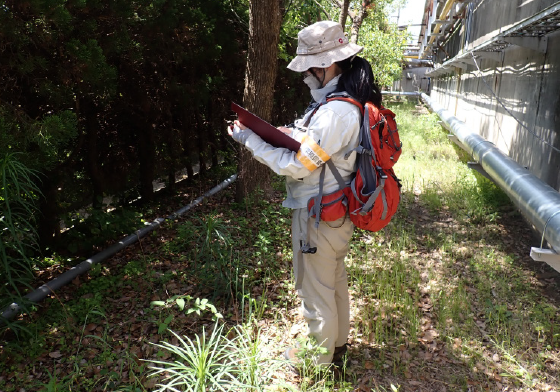
Plant survey
(SEKISUI NANO COAT TECHNOLOGY CO., LTD.) -
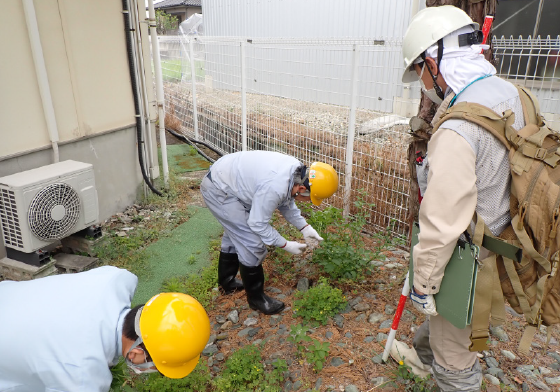
Lecture on eradication
(SHIKOKU SEKISUI CO., LTD.) -
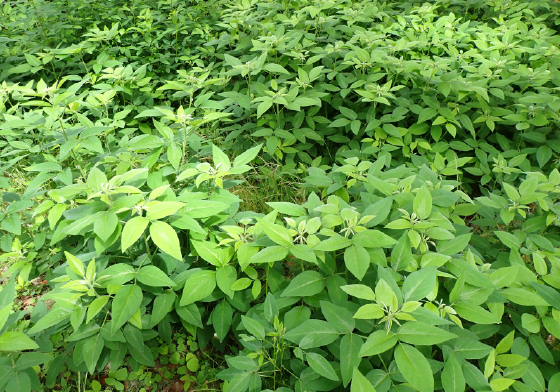
Example of a species to be eradicated
(Desmodium paniculatum)
Certified as a Site Coexisting with Nature by Japan’s Ministry of the Environment
- Out_E85
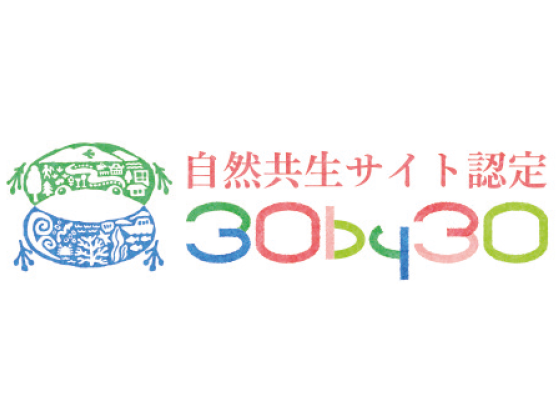
Sekisui Medical Co., Ltd.’s Iwate Plant was certified as a site coexisting with nature by Japan’s Ministry of the Environment.
Location: Hachimantai-shi, Iwate Prefecture Area: 27.8ha
The following items were highly evaluated by experts, which led to certification.
- A survey revealed that 951 species of flora, fauna, and spring water creatures grew in and inhabited the plant site.
- Among these species, the survey discovered 22 rare species, including Capricornis crispus (special protected species) and Glirulus japonicus (protected species).
- To create an environment that contributes to biodiversity, such as the continuous planting of deciduous broad-leaved trees by employees and the development of spawning grounds for Hynobius lichenatus and Zhangixalus arboreus, efforts were being made to engage in sustainable maintenance and management that leverages natural cycles.
- Out_E73
- Out_E74
- Out_E75
-
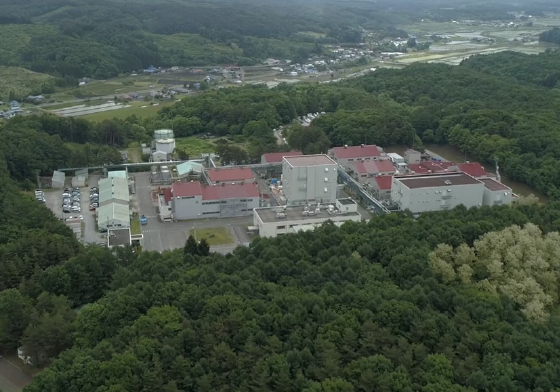
Panoramic view of Iwate Plant
-
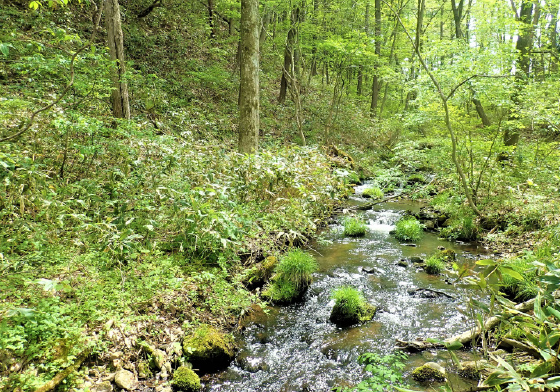
Typical landscape
-
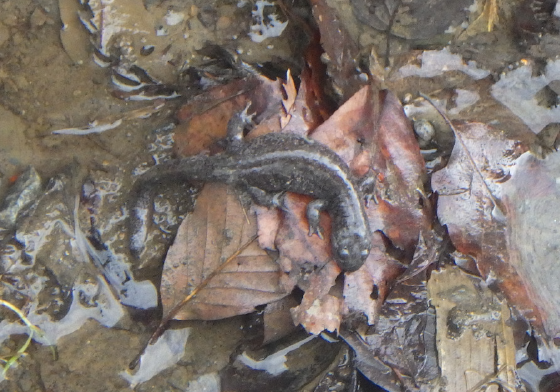
Hynobius lichenatus
Mangrove Reforestation Activities in Thailand
SEKISUI CHEMICAL Group is engaged in mangrove reforestation activities to restore and maintain the mangrove ecosystem in Thailand and to contribute to the local community.
In fiscal 2023, the Thai province of Nakhon Si Thammarat was buffeted by extreme weather conditions, which caused the tidal flats to become dry due to high temperatures. To address this grave situation, and in cooperation with local fishermen, about 30,000 trees on 10 ha of tideland were planted at the beginning of the monsoon season. Through observation of the growth and condition of the trees planted in fiscal 2022, we found that many of the trees had already sprouted branches and that supporting roots were firmly extending into the ground. These activities are contributing to the creation of carbon-rich tropical peatlands.
- Out_E76
- Out_E77
- Out_E78
-
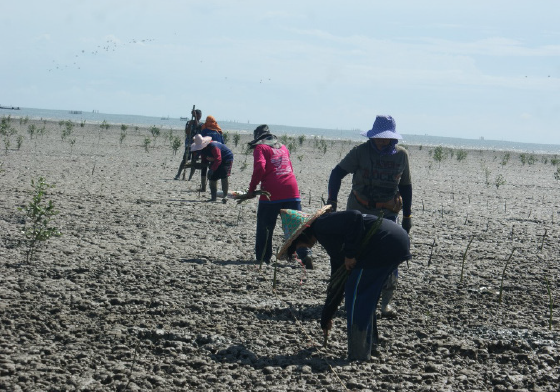
Afforestation on dry tidal flats
-
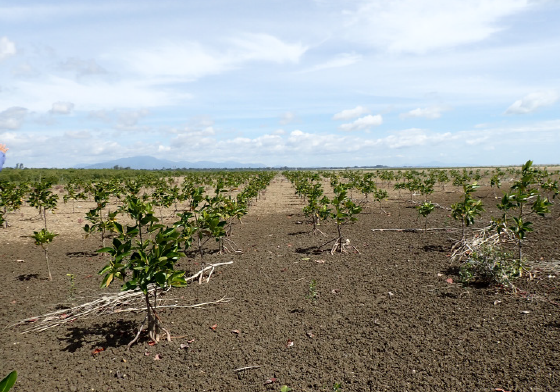
Afforestation undertaken in FY2022
-
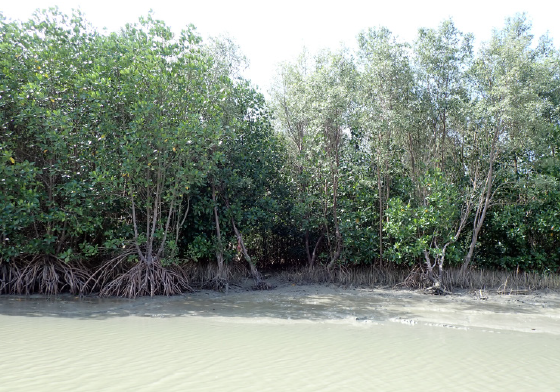
Tree planting conducted in FY2017
Collaboration with External Organizations
Corporate Organizations That Take Action with the Aim of Preserving Biodiversity
- Out_E72
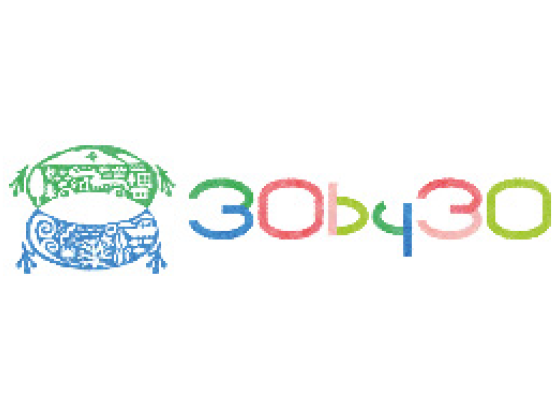
30by30 Alliance
-
Organizer・・・・・・・・・・・・・・・・Japan’s Ministry of the Environment
-
Significance / Objectives・・・Achievement in Japan of internationally agreed 30by30 targets
-
Activities・・・・・・・・・・・・・・・・・Compile and promote necessary measures to halt and restore biodiversity by 2030 (nature positivity), including OECM certification.
-
Our role・・・・・・・・・・・・・・・・・・Express support and aim to accelerate efforts through in-house and corporate collaboration.
Japan Business Initiative for Biodiversity (JBIB)
-
Significance / Objectives・・・Contribute to the conservation of biodiversity in Japan and overseas
-
Activities・・・・・・・・・・・・・・・・・Promote a variety of activities, such as research on biodiversity in collaboration with various companies.
-
Our role・・・・・・・・・・・・・・・・・・Exchange opinions with companies that promote biodiversity conservation, share case studies while accelerating in-house efforts, and raise awareness of social efforts.
Keidanren Declaration of Biodiversity Initiative
-
Significance / Objectives・・・Work to realize a sustainable society by building a society in harmony with nature
-
Activities・・・・・・・・・・・・・・・・・Voluntarily and proactively address the seven items that make up the Keidanren Declaration of Biodiversity and Action Guidelines (revised version)
-
Our role・・・・・・・・・・・・・・・・・・Endorse and work to mainstream biodiversity by developing activities in accordance with this spirit and aspiration.
Activities to Conserve Green Spaces
We work together with an environmental consulting firm on environmental conservation activities and development of local environment, such as research on ecosystems at production sites and laboratories, conservation of biodiversity, and eradication of invasive species.
Environmental Conservation Activities
As part of efforts to develop human resources that contribute to the environment, we are working with local governments, academia, NGOs, NPOs, and other organizations at our bases in Japan and overseas to conduct environmental conservation activities worldwide.
Results from the JBIB Land Use Score Card®.
| FY2023 | |
|---|---|
| JBIB Land Use Score Card® | Up 1.5 points (compared with FY2022) |
| Index | Calculation Method |
|---|---|
| Points of JBIB Land Use Score Card® |
The JBIB Land Use Score Card® is an Ikimono Symbiotic Coexistence Enterprise® promotion tool that aims to evaluate the degree of contribution to biodiversity of company-owned land. This Score Card serves as a sheet that evaluates the area, quality, and management system of green spaces at each business site on a 100-point scale. The JBIB Land Use Score Card® is used to evaluate each business site for the fiscal year in question, and to calculate the increase from the number of points compared with FY2022. The indicator is the average point increase across all business sites. |
